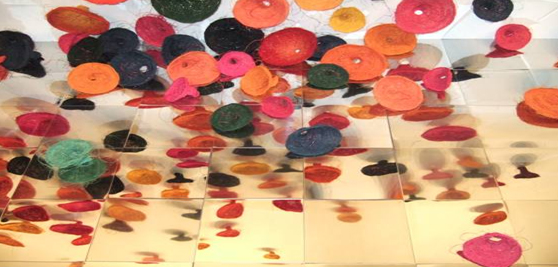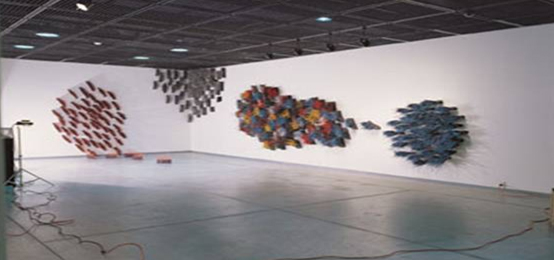Curriculum Vitae

Yoo Joung Hye
+82 2 447 0118 (H) +82 11 774 7767 (Mobile) jounghye-yoo@hanmail.net
Recent Works
10th Solo exhibitions (Seoul, New York, Bosnia & Hercegovina, China, Japan etc
MANIF' 98 at the Seoul Arts Center in Korea
1999/2001 Invitational Exhibition (Cheongju,Korea) International Craft Biennale
2000 ¡°ITAMI" International Craft Exhibition, (Japan)
2002 International Tapestry Art Biennale (Daegu, Korea)
2002/2004 "From Lausanne to Beijing" International Tapestry Art Biennale, at (Museum in Beijing)
2004 Surging from Far East Surging (National Gallery BiH Sarajevo)
2004 International Textile Art Doucument in EXCO ( Korea )
2005 Dawn Light Sympsoium ( Gosford Gallery, Australia , New Castle )
2006 Nine Dragon Heads DMZ & JSA
2007 Meeting Downhill ( Den Haag, Holland / Quartair Gallery )
2007 Magic Garden ( Kunst Forum. Kramsach. Tirol. Austria )

¡°The flowers of difference¡±, reflected in the mirror of Eros Dong-kwang
Chang (Independent Curator, Adjunct Professor of Sookmyung Women¡¯s University)
1. Fragmentary thoughts about the mirror unexpectedly recurred to my mind
The mirror is the eternal room of existence. It is a space conferred by the light that reflects one¡¯s being. Within darkness the object can not be reflected in the mirror. It is the very existence of light that enables us to discover ourselves and clearly defines not only who we are but everything else that surrounds us. It shows how we look like and differentiate us from the others. But the mirror always reflects the right side and left side inversely. It is the inevitable result of confrontation. This explains why whenever we see ourselves and other objects in the mirror we have to transpose them so that we can perceive them just as they are. The transposition between right and left to grasp reality is accompanied by abstract thought and illusion. As a matter of fact, the form that is reflected in the mirror that seems to be genuinely real is not so. This kind of phenomenon can be seen when the photographer attempts to take a picture of a certain object. It can also be seen in the printing of a photography. The subject caught by the lens of the camera is the result of the transposition of the right and left. This inevitable contradiction of cause and effect eventually recalls to my mind the philosophy of art that maintains that everything we think is real is nothing but the shadow of a phantasmagoric vision. I first met artist Yoo Joung-hye when I was a curator and since she has been a kind of ¡®mirror¡¯ to me. Her left side has always been my right side and I never expressed any doubts about such difference. And at times when we both walked side by side I even thought for a moment that my right and left side coincided with hers but that was because I only saw a part of herself and not her whole existence. If I wanted to convert my right and left side into her right and left I would have no other way but to get into her body and merge into one with her. The unexplainable question about the inverted position of the object symbolizes the imperfection of our sense of perception when observing a work of art. This dilemma has always haunted my mind. Fortunately, sculptors and painters do not need to be as conscious of the right and left side as photographers do when observing an object. The fact that both the artist and the viewer are seeing things from the same perspective is of great significance in the process of emotional empathy.

2. In the Atelier, The flowers of sexuality bloom a three-dimensional space
As a fiber artist Yoo Joung-hye has always dealt with the theme of love in her works. Since 1984, when she opened her first solo exhibition, there have been big and small changes in her artistic ideals and thoughts but these variations are comparable to the cycle of a tree that changes its clothes as a new season arrives. If an artist sings life through a visual chord, the trace of Yoo¡¯s works symbolize the extremely difficult search for the meaning of ¡®love¡¯. This process is like the water running down the valley that flows towards the big ocean and the voyage of the disciplinant that goes in search of the highest state of enlightenment. From the point of view of the writer, the works displayed in this solo exhibition are the ones that are most closely related to the artworks of her 2nd solo exhibition in 1988. Under the title ¡®The Actions and Forms of Love¡¯she created her works using cotton yarn, hemp thread and abaca thread using the weaving technique. The form of these pieces of work resembled an oval cut in the middle. Red was the dominant color of her creations but colors like yellow, green and the light brown shade of the abaca thread diffused a gradation effect in her weave works. The most eye-catching features of these artworks were the way threads were arranged bringing up the image of real hair and the irregular and spontaneous composition of threads on a three- dimensional cloth suggesting the sexual organs of a woman. In fact, the female sexual organs symbolize the conception of life, the essence of motherhood and the gate of Eros that merge man and woman into one. Of course, no one can deny that the ultimate ideal of love involves not only physical contact but a psychological bond known as spiritual response. The search for the ideal model of love through the union of the spirit and body has been of universal consent in all times and places. There is a term in psychology known as Oedipus complex that refers to a kind of sexual obsession towards one¡¯s mother. Man by instinct has the desire to satisfy his sexual wants and lack of love. That explains the endless adoration and burning desire to find a sensual object to maximize this sexual satisfaction. Sigmund Freud defined such need as Libido. Libido, the energy of sexual instinct, is the root that stimulates sexual love between man and woman. The form of the Libido represented in Yoo Joung-hye¡¯s ¡®Actions and Forms of Love?suggests a visual ecstasy that is strong enough to bring up the image of sexuality. ¡®Erotical Flower¡¯ displayed in this exhibition are variant forms that suggest a new visual wave. If the works exhibited in ¡®Actions and Forms of Love¡¯ were about 2 meters long and made of weave,¡®Erotical Flowers¡¯ are much smaller in scale, about 20-30 centimeters, and they are a combination of weaving technique and industrial materials. At first glance, each unit occupies a three-dimensional space and they are all gathered together and arranged in a variable form creating a kind of stock. The colors of ¡®Erotical Flower¡¯ harmonize with one and other and create a spectrum that resembles a dance in groups.

3. From the approaching-a garden of Eros
As you all may know, in the book <The Myth of Greece and Rome>, ¡®Eros¡¯ is the son of Aphrodite and the God of Love. He is the messenger who serves as a medium between man and god, myth and reality and earth and heaven. Even though Yoo Joung-hye¡¯s ¡®Erotical Flowers¡¯ are small, three-dimensional fiber works they are at the same time the free incarnation of sentiments and passion that are displayed on the ceiling, walls and floor of the exhibition hall. These variable installation artworks are the ¡®Flowers of Difference¡¯ that suggest erotism and symbolize sexuality. The association with other elements generates difference and dissimilarity within her works and so we are induced to convert the psychological insight of the libido into artistic thinking. Yoo Joung-hye has not hesitated even for a moment to experiment a new form in her works. Besides, the artist attempted to express the subjects of ¡®Love¡¯ and ¡®Life¡¯ just as they are, from a pure and genuine perspective, based on the conception of basic instincts. Yoo selected a wide variety of materials such as plastic tubes used in films of electric wires and enamel wires of network cables assembling them together with the forms she attempted to create. Rather than focusing on how the work will be seen from the viewer¡¯s perspective we can grasp a strong desire in Yoo to create the form she really wants and transfer all her sensitivity into the space. The industrial materials are the result of the technical reproduction era we live in, they are the hair of the ground, and as transmitters of energy all these materials, conveyed more effectively the purpose of the artist. The metaphoric forms that transmit sexuality and erotism in this solo exhibition are presented to us as the most genuine form of Libido, which is the basic instinct that originates within man¡¯s desire. In short, the various colors of the flowers of Eros and the units that create new forms and differences are the very expression of man¡¯s true self. In the same way the mirror reflects the inverted image of me.
A reality that is not reality. A visual fantasy inside the mirror.
.